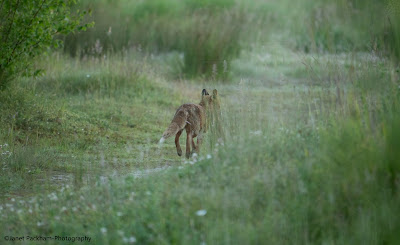According to the regional weather report the ESE breeze continued till lunchtime. It wasn't like that locally. After 09:30the breezed swirled around, veering from easterlies to westerlies and back again! Hot and sunny for most of the day, but a very heavy shower by evening.
First an update from yesterday on Middleton Nature Reserve. Pete saw:
Stock Dove 2 flew into the water treatment works
Lunar Hornet Moth attracted to pheromone lure near the gate opposite the water treatment works
South shore (MD)
This light wind was from the ESE when I started at 09:30. As soon as I got to the saltmarsh an Emperor dragonfly came in off the sea - I started a tally chart - needn't have bothered, I didn't see another dragonfly!
All along the sea wall the wind was predominantly SSW, but by 10:10 when I'd arrived at the roundhead there was a short period of east wind.
There was nothing coming in off the sea, but quite a few butterflies feeding.
Meadow Brown 12
Painted Lady 2
Common Blue 1
Small Tortoiseshell 2 - these actually flew out to sea in a period of west breeze, shortly followed by a Red Admiral that had flown along the sea wall.
I was wondering if the Meadow Brown were just the result a successful breeding, but I did eventually see one come in off. The only other insect seen coming in was a moth, probably a Silver Y.
Rock Pipits 4 (foreshore, Red Nab, waterfall and just one bird (not the ringed male) taking food to the chicks in the lighthouse nest hole).
Linnet pair with 4 young plus 2 other pairs at least.
 |
Today's newly fledged Linnets were quite downy
I suspect this is a second lot to be fledged here (MD) |
Curlew c80 - 62 in two groups flying north, but a steady stream of individual birds too
I hung around a bit, as I wanted to watch the beach next to the wooden jetty become exposed, to see if it attracted any Meds. I wasn't disappointed, but a bit surprised!
Mediterranean gulls 2, possibly 3 adult. 1 x 3rd calendar year. 3 x 2nd calendar year.
The first surprise was a feeding technique I've not seen before. The water was so clear, the Meds were diving for Sandmason worms feeding under water.
 |
| Adult Mediterranean gull diving for Sandmason worms |
The reality wasn't as dramatic as the above picture suggests. Here is the full sequence. You can see the adult looking for available worms while the 3rd calendar year bird watches on. The dive is successful, but the gull has the worm's tube as well as the worm. Not easy to sort out without risking it being pinched, so it ended up Flying off.
The second surprise was the noise the adults were making. There was an adult pair calling, not sure if the above adult was one of them. Normally the only noise they make are soft "keep away" grunts when they are defending their feeding patch. Today's calls were loud and haunting, you can hear them in the next clips.
This is the 3cy bird trying out what it learned by watching the adult. But not quick enough, it just ended up with an empty piece of tube.
The 2cys were also trying to feed this way, but I didn't see them catch anything. Not a lot happening in this clip, but you can hear the adults calling.
These are the calling adults. They appear to be a pair, I assume the calling is associated with bonding. But I don't really know (MD)
 |
A nice shot of the 3rd calendar year Mediterranean gull
showing the black markings on the primaries |
Heysham Nature Reserve (KE)
Dark Green Fritillary 2 in South West corner of the plateau
Janet took this shot of a "grass moth" here yesterday. Don't know if it's laying an egg or just a bubble of waste, I suspect the latter (MD)





















































